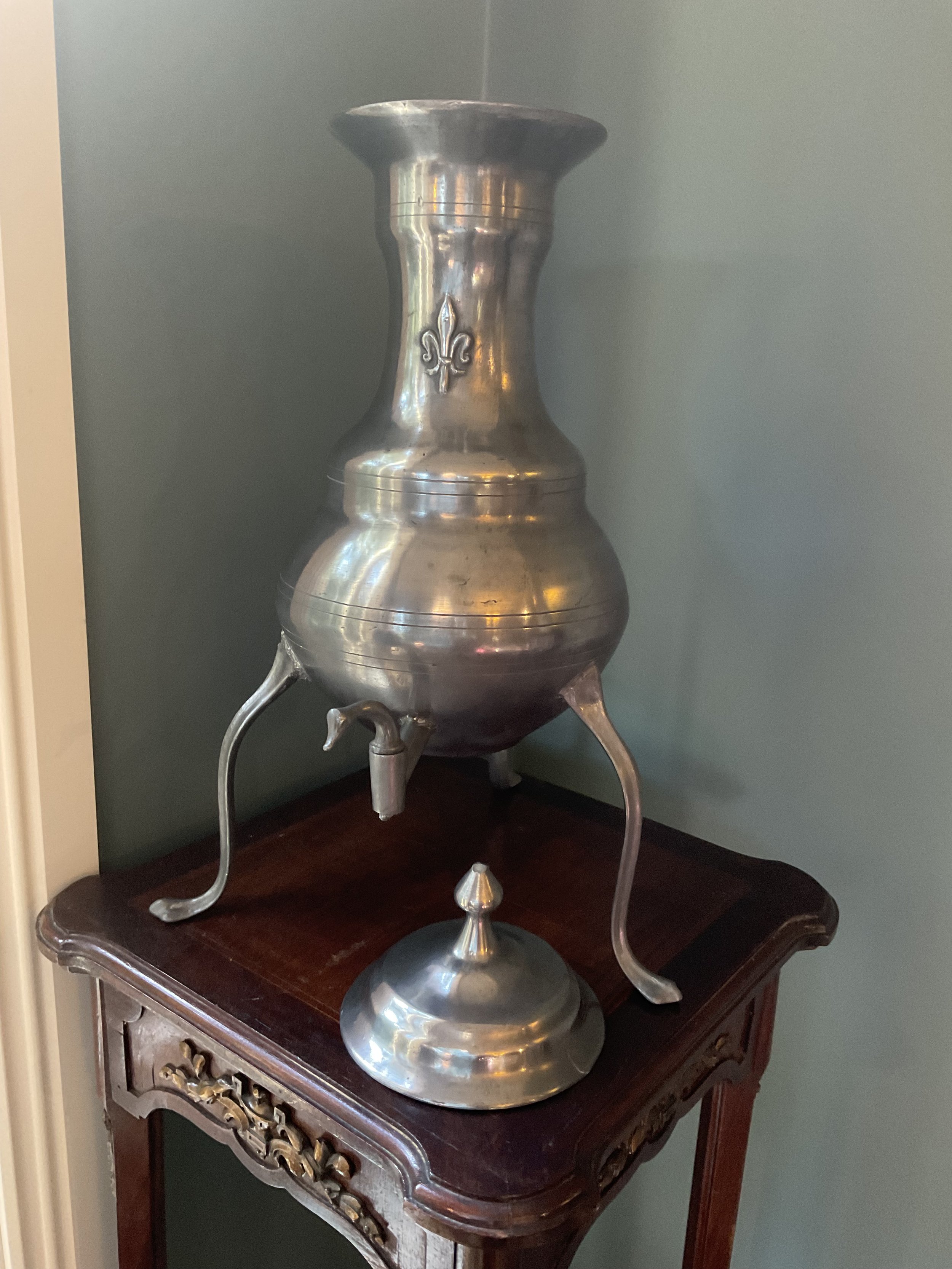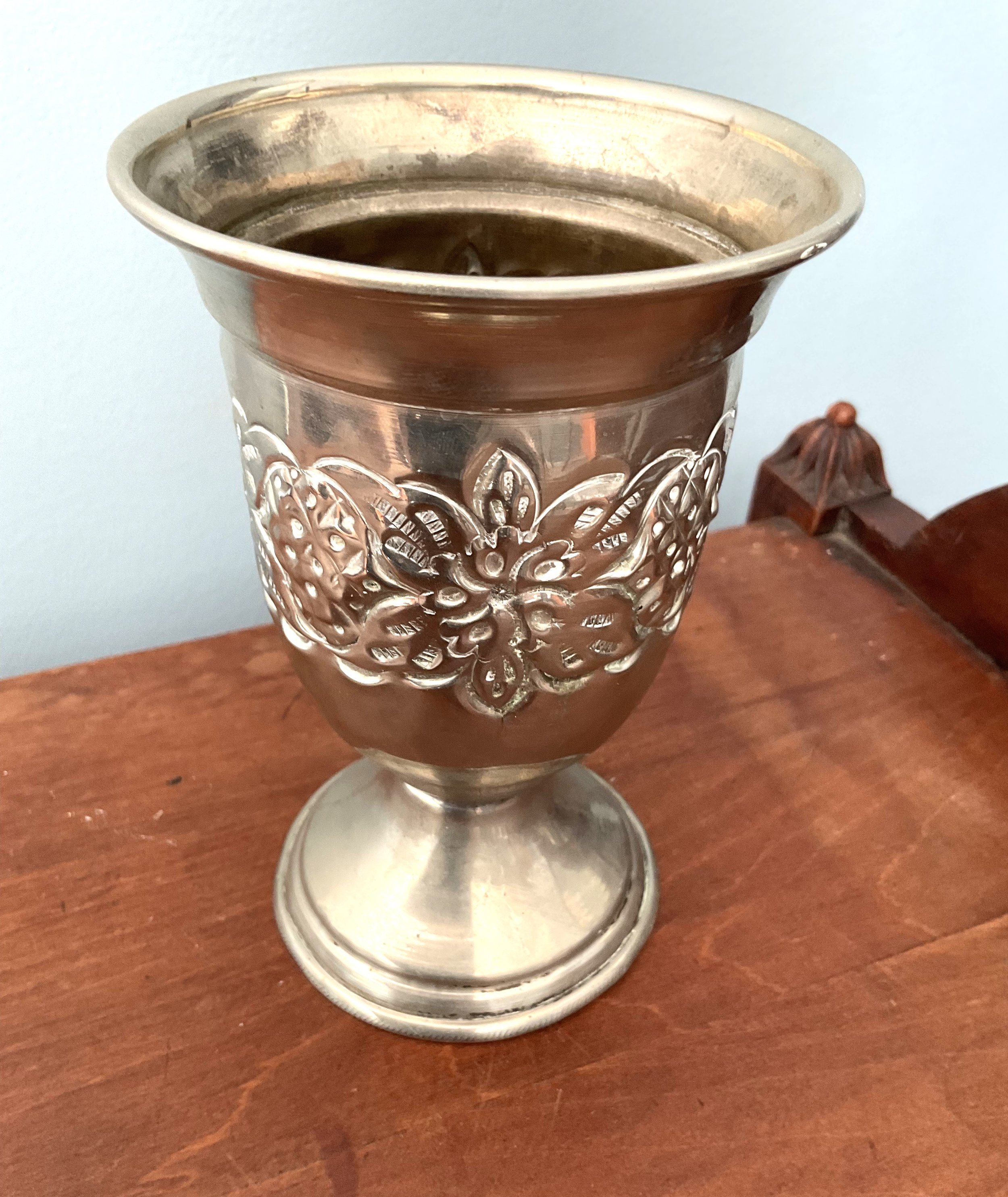 Image 1 of 8
Image 1 of 8

 Image 2 of 8
Image 2 of 8

 Image 3 of 8
Image 3 of 8

 Image 4 of 8
Image 4 of 8

 Image 5 of 8
Image 5 of 8

 Image 6 of 8
Image 6 of 8

 Image 7 of 8
Image 7 of 8

 Image 8 of 8
Image 8 of 8









French Antique Tea Urn
This elegant French antique urn is made from pewter. It would have been used for tea, coffee or hot water. Circa 1900, it has a stylish design . Its simple shape features organic curves and the legs have an almost life like stance. A fleur de lis sits prominently on the front of the urn. This urn is indeed quirky. The tap has been shaped into the head of a duck and the three legs have duck feet. The squatted stance of the urn is reminiscent of a duck.
The earliest known piece of pewter was found in an Egyptian tomb, 1450 BC. Pewter is a blend of several types of metals, usually tin, copper and antimony. It is easy to work with and versatile. During the 16th and 17th centuries, pewter became highly fashionable. This era was the Golden Age of Pewter. It was the chief component of tableware and liturgical objects (such as plates, goblets and candlesticks) across Europe.
The art of casting resulted in the production of beautiful objects, especially hollow wear such as cream jugs, teapots and tankards. New beverages such as tea and coffee became a craze at the time and this fitted beautifully with the production of pewter hollow wear. Pewter became prized not only for its practical purposes but also as objects of decorative beauty and works of art. By the 19th century, the popularity of pewter had waned. Porcelain, glass and steel had overtaken pewter and were mass produced. The Art Nouveau period, with its emphasis on floral designs enabled pewterers to craft some masterpieces. Art Nouveau pewter is popular and highly collectable. Valuable old pewter is marked by simplicity, good outline and an absence of excessive decoration.
The urn stands 48 cms in height. There is a maker’s mark underneath. IThis urn would look stunning on a sideboard or even on a kitchen bench.
This elegant French antique urn is made from pewter. It would have been used for tea, coffee or hot water. Circa 1900, it has a stylish design . Its simple shape features organic curves and the legs have an almost life like stance. A fleur de lis sits prominently on the front of the urn. This urn is indeed quirky. The tap has been shaped into the head of a duck and the three legs have duck feet. The squatted stance of the urn is reminiscent of a duck.
The earliest known piece of pewter was found in an Egyptian tomb, 1450 BC. Pewter is a blend of several types of metals, usually tin, copper and antimony. It is easy to work with and versatile. During the 16th and 17th centuries, pewter became highly fashionable. This era was the Golden Age of Pewter. It was the chief component of tableware and liturgical objects (such as plates, goblets and candlesticks) across Europe.
The art of casting resulted in the production of beautiful objects, especially hollow wear such as cream jugs, teapots and tankards. New beverages such as tea and coffee became a craze at the time and this fitted beautifully with the production of pewter hollow wear. Pewter became prized not only for its practical purposes but also as objects of decorative beauty and works of art. By the 19th century, the popularity of pewter had waned. Porcelain, glass and steel had overtaken pewter and were mass produced. The Art Nouveau period, with its emphasis on floral designs enabled pewterers to craft some masterpieces. Art Nouveau pewter is popular and highly collectable. Valuable old pewter is marked by simplicity, good outline and an absence of excessive decoration.
The urn stands 48 cms in height. There is a maker’s mark underneath. IThis urn would look stunning on a sideboard or even on a kitchen bench.
This elegant French antique urn is made from pewter. It would have been used for tea, coffee or hot water. Circa 1900, it has a stylish design . Its simple shape features organic curves and the legs have an almost life like stance. A fleur de lis sits prominently on the front of the urn. This urn is indeed quirky. The tap has been shaped into the head of a duck and the three legs have duck feet. The squatted stance of the urn is reminiscent of a duck.
The earliest known piece of pewter was found in an Egyptian tomb, 1450 BC. Pewter is a blend of several types of metals, usually tin, copper and antimony. It is easy to work with and versatile. During the 16th and 17th centuries, pewter became highly fashionable. This era was the Golden Age of Pewter. It was the chief component of tableware and liturgical objects (such as plates, goblets and candlesticks) across Europe.
The art of casting resulted in the production of beautiful objects, especially hollow wear such as cream jugs, teapots and tankards. New beverages such as tea and coffee became a craze at the time and this fitted beautifully with the production of pewter hollow wear. Pewter became prized not only for its practical purposes but also as objects of decorative beauty and works of art. By the 19th century, the popularity of pewter had waned. Porcelain, glass and steel had overtaken pewter and were mass produced. The Art Nouveau period, with its emphasis on floral designs enabled pewterers to craft some masterpieces. Art Nouveau pewter is popular and highly collectable. Valuable old pewter is marked by simplicity, good outline and an absence of excessive decoration.
The urn stands 48 cms in height. There is a maker’s mark underneath. IThis urn would look stunning on a sideboard or even on a kitchen bench.






















